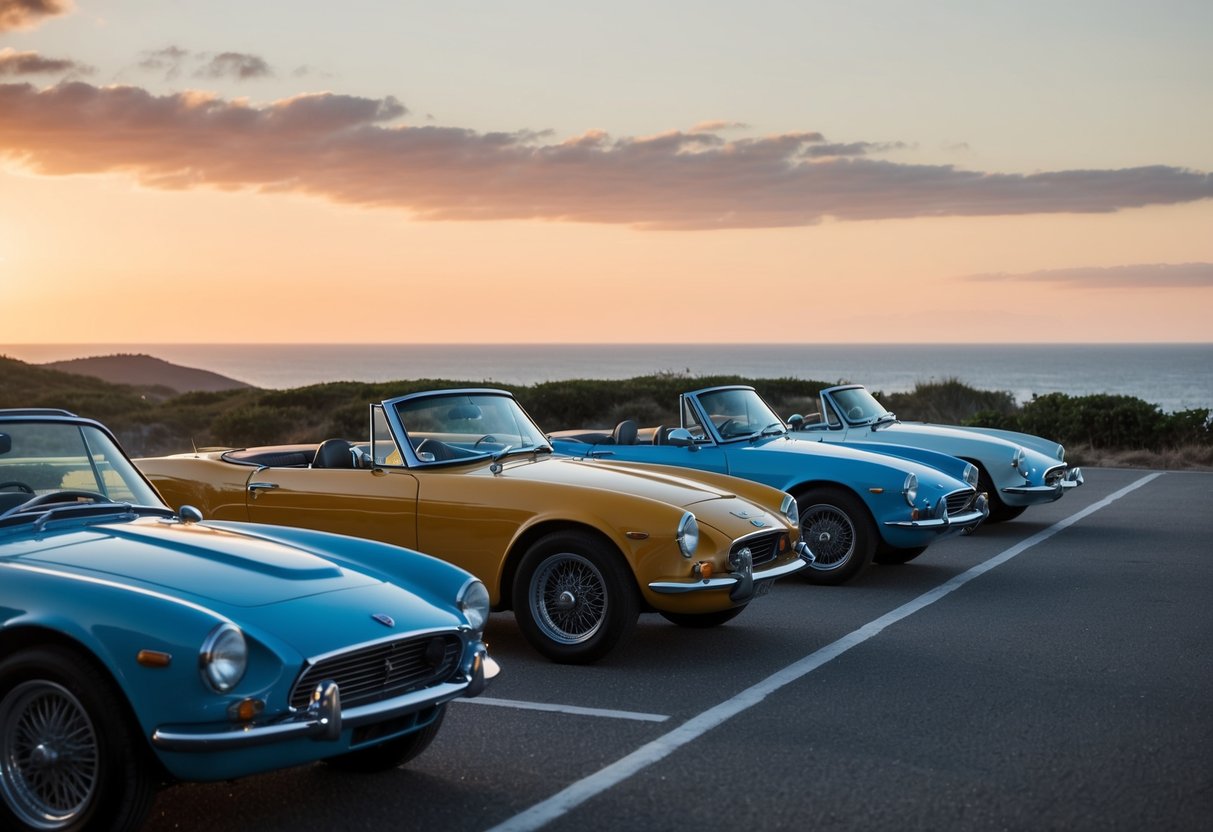
British Roadsters
British roadsters epitomize style and performance, offering iconic designs and legendary status. The Jaguar E-Type became a symbol of automotive beauty with its sleek lines. The Lotus Elan highlighted engineering brilliance, and the Austin-Healey Sprite offered an accessible sports car experience.
Jaguar E-Type: A Roadster Revolution
The Jaguar E-Type, introduced in 1961, is often celebrated as one of the most beautiful cars ever made. Its design, characterized by long, sweeping lines and elegant curves, represented a new era in automotive styling.
Equipped with a 3.8-liter engine in its earlier models, the E-Type delivered impressive performance for its time. The roadster version, with its open-top allure, captured the imagination of car enthusiasts worldwide. It combined aerodynamic design with a powerful engine, setting new standards in both aesthetics and engineering.
The legacy of the Jaguar E-Type rests not only in its striking appearance but also in its advanced technology. Independent suspension and disc brakes were considered groundbreaking then. These features made it as functional as it was visually appealing.
Lotus Elan: Synonymous with British Engineering
The Lotus Elan, introduced in the 1960s, showcased the essence of British engineering ingenuity. Small in size but mighty in performance, it became an icon for its lightweight design and responsive handling.
The Elan was powered by a 1.6-liter twin-cam engine, which offered impressive agility and speed. Its innovative fiberglass body and backbone chassis design contributed to its lightweight nature. This reduced mass allowed it to outmaneuver many of its heavier contemporaries.
Colin Chapman, founder of Lotus, emphasized the importance of reducing weight to improve performance. This philosophy was fully realized in the Elan, making it a favorite among driving purists who valued handling over raw power. The Lotus Elan remains a testament to the power-to-weight ratio’s influence on driving dynamics.
The Quintessential Austin-Healey Sprite
The Austin-Healey Sprite made its debut in 1958, quickly earning the nickname “Frogeye” or “Bugeye” due to its distinctive headlamp design. The Sprite Mark I was affordable and approachable, allowing more enthusiasts to experience the joys of a roadster.
Under the hood, a modest 948cc engine delivered a spirited drive, perfectly aligning with its lightweight construction. Despite its unassuming power output, the Sprite carved a reputation for being fun and engaging, especially on twisty roads.
Accessible to a broad audience, the Austin-Healey Sprite contributed to the democratization of the sports car experience. It captured the essence of affordable fun, making it beloved among classic car enthusiasts. Its enduring charm and character continue to capture the imagination of many even today.
The Evolution of Convertible Roof Mechanisms
Convertible roof mechanisms have significantly transformed the driving experience. From the classic soft tops to the innovative retractable hardtops, each development has enhanced the functionality and aesthetics of convertibles.
From Soft Tops to Retractable Hardtops
Soft tops were the earliest form of convertible roofs. They were typically manual and made of fabric, offering a simple way to embrace open-air driving. Despite their charm, they faced issues such as limited insulation and durability. The introduction of retractable hardtops marked a pivotal shift, allowing drivers to enjoy better security and weather protection. These systems, often electrically operated, transformed the industry by combining the elegance of a convertible with the sturdiness and comfort of a coupe.
Innovations in Modern Luxuries with Bentley
Bentley stands at the forefront of modern convertible innovation, especially with models like the Bentley Azure. The focus here is on luxury coupled with engineering excellence. Bentley’s convertible roofs are designed to ensure a seamless experience. Their mechanisms feature enhanced soundproofing and advanced materials, ensuring a quiet ride even with the top down. These roofs reflect Bentley’s commitment to offering uncompromised luxury and performance, ensuring that passengers enjoy the full benefits of both an open and enclosed driving environment.
Restoration and Maintenance of Classic Convertibles
Classic convertibles are treasured for their timeless appeal and driving pleasure. Proper restoration and maintenance are essential to preserve their historical value and ensure they remain in perfect running condition.
Preserving History: Restoration Techniques
Restoring vintage convertibles demands an understanding of both their aesthetic and mechanical aspects. Experts often start by assessing the vehicle’s bodywork, which may involve repairing or replacing panels while preserving original features. Selection of authentic parts is crucial for authenticity. Mechanical components, such as the engine and transmission, are carefully examined. This may involve rebuilding engines to factory specifications or sourcing rare parts. Attention to upholstery, chrome fixtures, and convertible tops ensures the restoration respects the car’s historical significance. Painting is another critical stage, requiring historically accurate colors and techniques. The process demands precision and patience, with restorers often relying on archival photographs and documents to guide their efforts.



